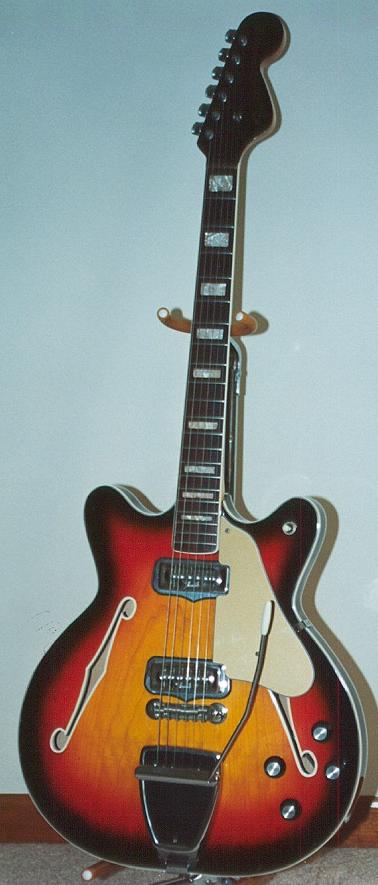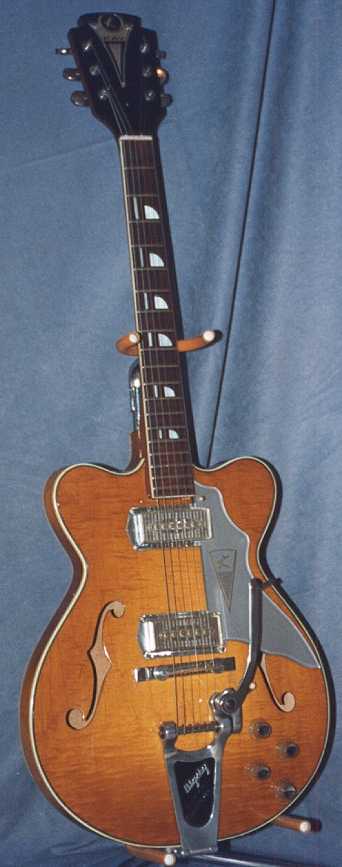Showdown: Fender Coronado II vs Kay Jazz II
by Greg Gagliano
Copyright 1996, 20th
Century Guitar Magazine.
Here’s a comparison of two guitars that were introduced in an attempt
to get a piece of the electric thinline market that was essentially cornered
by Gibson. These guitars are not only similar in construction philosophy,
but also in that they both failed at getting marketshare. The Coronado II
was one of the first non-Leo Fender designed guitars introduced by Fender
Musical Instruments in mid-1966. The series was also the first to use non-Leo
Fender designed pickups. The Jazz II came onto the scene in the wake of
Kay’s heyday with the Barney Kessel and Upbeat models. Today’s test subjects
are a 1967 Fender Coronado II and circa 1963 Kay Jazz II.
 The Fender and Kay use similar formulas for guitar construction. They both
have thinline, double cutaway, laminated maple bodies; bolt-on maple necks
with bound rosewood fingerboards; dual single coil pickups with volume and
tone controls for each; and vibrato tailpieces. That’s where the similarites
end. The Kay’s body, at 15 inches, is not as wide as the 16 inch Fender, and
it’s top is thinner as well. The thinner top on the Kay does not seem to
give it any advantage over the Fender acoustically. The neck profiles on
these two thinlines are like night and day. The Kay’s neck is U-shaped with
tall shoulders, but it’s a far cry from the Louisville slugger necks found
on earlier Kay guitars. It’s actually very comfortable to play and the neck
on this specimen was dead straight. The Coronado necks come in two flavors:
C-shaped oval and U-shaped round. I’ve found more of the U-shaped necks on
Coronado I’s, but at least 25 to 30 percent of the Coronado II’s I’ve sampled
have the rounder neck as well. The example in this comparison has the oval
neck which feels very similar to the mid to late 1960s Jazzmaster neck.
With its Grover Rotomatic tuners, the Kay ups the ante to the Fender’s "F"tuners.
The Grovers are far more precise and user friendly.
The Fender and Kay use similar formulas for guitar construction. They both
have thinline, double cutaway, laminated maple bodies; bolt-on maple necks
with bound rosewood fingerboards; dual single coil pickups with volume and
tone controls for each; and vibrato tailpieces. That’s where the similarites
end. The Kay’s body, at 15 inches, is not as wide as the 16 inch Fender, and
it’s top is thinner as well. The thinner top on the Kay does not seem to
give it any advantage over the Fender acoustically. The neck profiles on
these two thinlines are like night and day. The Kay’s neck is U-shaped with
tall shoulders, but it’s a far cry from the Louisville slugger necks found
on earlier Kay guitars. It’s actually very comfortable to play and the neck
on this specimen was dead straight. The Coronado necks come in two flavors:
C-shaped oval and U-shaped round. I’ve found more of the U-shaped necks on
Coronado I’s, but at least 25 to 30 percent of the Coronado II’s I’ve sampled
have the rounder neck as well. The example in this comparison has the oval
neck which feels very similar to the mid to late 1960s Jazzmaster neck.
With its Grover Rotomatic tuners, the Kay ups the ante to the Fender’s "F"tuners.
The Grovers are far more precise and user friendly.
The Gold K pickups on the Jazz II are the same ones used on the high line
Kay electric archtops of the late 1950s. That is to say, they are most excellent.
These pickups produce a well balanced tone with a bit of boost in the midrange
and are suited to most forms of popular music. The DeArmond-Rowe pickups on
the Fender are anemic and thin by comparison. It takes some fiddling with
the amp tone controls to compensate for their shortcomings. It’s a shame that
these units are riveted together. It would be neat if they could be rewound
or rebuilt to give them a little more pep. The tremolo tailpieces are quite
different between these guitars. The Bigsby wangs flawlessly and the Kay
suffers from an occassional tuning problem if the Bigsby is used aggressively.
The floating unit on the Fender is very similar to the one found on the Mustang.
The Fender unit is less stable than the Bigsby and moves quite a bit which,
of course, affects tuning and sustain. The very long trem arm makes accurate
whammying somewhat of a chore.
So far, it looks like the Kay has the advantage over the Fender, which
may surprise some people considering that Kay was a "budget" brand and the
Coronado II was even more expensive than the Jaguar. Still, neither of these
guitars could compete with the semi-hollow ES-335s and Starfires in a rock
and roll situation. They just feedback too much, even in basement "jam band"
settings. However, for toodling around at home, they work great. Both can
generate really cool jazz tones and both are very comfortable to play. The
Fender’s strong point’s include it’s neck profile and quality of construction.
The Kay has way better tuners, pickups, and tailpiece. Either would make a
fine practice instrument and neither of these hold much interest in the vintage
market, except for the Wildwood Coronados. Hence, they can be acquired for
a reasonable price ($250 - 500).
The author, who really does like his Coronado II despite its shortcomings,
can be contacted c/o TCG.
Back to GGJaguar's
Bibliography
 The Fender and Kay use similar formulas for guitar construction. They both
have thinline, double cutaway, laminated maple bodies; bolt-on maple necks
with bound rosewood fingerboards; dual single coil pickups with volume and
tone controls for each; and vibrato tailpieces. That’s where the similarites
end. The Kay’s body, at 15 inches, is not as wide as the 16 inch Fender, and
it’s top is thinner as well. The thinner top on the Kay does not seem to
give it any advantage over the Fender acoustically. The neck profiles on
these two thinlines are like night and day. The Kay’s neck is U-shaped with
tall shoulders, but it’s a far cry from the Louisville slugger necks found
on earlier Kay guitars. It’s actually very comfortable to play and the neck
on this specimen was dead straight. The Coronado necks come in two flavors:
C-shaped oval and U-shaped round. I’ve found more of the U-shaped necks on
Coronado I’s, but at least 25 to 30 percent of the Coronado II’s I’ve sampled
have the rounder neck as well. The example in this comparison has the oval
neck which feels very similar to the mid to late 1960s Jazzmaster neck.
With its Grover Rotomatic tuners, the Kay ups the ante to the Fender’s "F"tuners.
The Grovers are far more precise and user friendly.
The Fender and Kay use similar formulas for guitar construction. They both
have thinline, double cutaway, laminated maple bodies; bolt-on maple necks
with bound rosewood fingerboards; dual single coil pickups with volume and
tone controls for each; and vibrato tailpieces. That’s where the similarites
end. The Kay’s body, at 15 inches, is not as wide as the 16 inch Fender, and
it’s top is thinner as well. The thinner top on the Kay does not seem to
give it any advantage over the Fender acoustically. The neck profiles on
these two thinlines are like night and day. The Kay’s neck is U-shaped with
tall shoulders, but it’s a far cry from the Louisville slugger necks found
on earlier Kay guitars. It’s actually very comfortable to play and the neck
on this specimen was dead straight. The Coronado necks come in two flavors:
C-shaped oval and U-shaped round. I’ve found more of the U-shaped necks on
Coronado I’s, but at least 25 to 30 percent of the Coronado II’s I’ve sampled
have the rounder neck as well. The example in this comparison has the oval
neck which feels very similar to the mid to late 1960s Jazzmaster neck.
With its Grover Rotomatic tuners, the Kay ups the ante to the Fender’s "F"tuners.
The Grovers are far more precise and user friendly. 